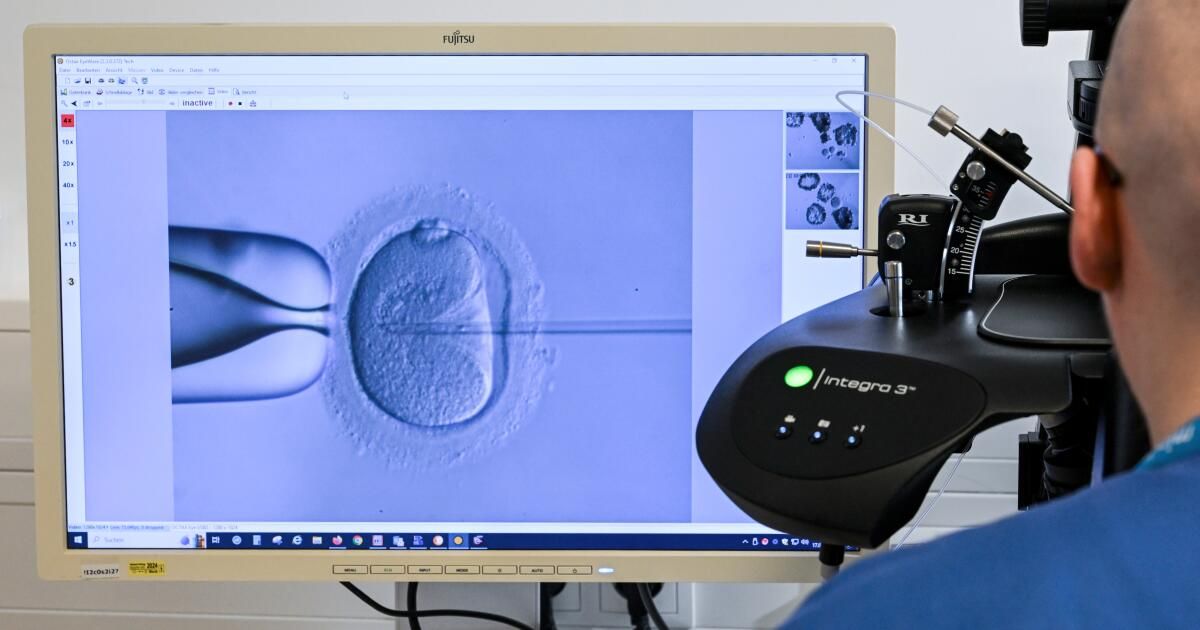I never considered myself a mass murderer, but the Alabama Supreme Court has a different idea.
Last month, the court ruled Frozen embryos are legally children.allowing several IVF patients to sue a fertility clinic for wrongful death for the inadvertent destruction of their, um, refrigerated children.
To be clear, you cannot freeze a child and then thaw them unharmed. An embryo, which can be frozen, is not a microscopic child; rather, it is a small collection of cells that develops after a sperm and egg combine. People undergoing in vitro fertilization, or IVF, try to produce as many embryos as possible outside the body and transfer the best of the batch into the uterus to increase the chances of a successful birth.
This often results in unused embryos being frozen for later use or eventually discarded or donated.
I know this because 13 years ago, my wife and I underwent fertility treatment, a months-long process that, in retrospect, foreshadowed the ups and downs of parenthood by putting us in a difficult emotional and financial situation. We failed multiple conservative treatments before my wife opted for IVF, a therapy that essentially took over her life for an entire summer, with no guarantee it would work.
Looking back on our experience, I dread the thought of prospective parents in Alabama suffering a similar ordeal but under the patriarchal gaze of Supreme Court justices. Several Alabama fertility clinics have already IVF suspended since the February 16 ruling; I wonder about the different stages of treatment in which these patients were left in the worst situation.
Some had probably been receiving daily injections of hormones for a week or two that hyperstimulate the growth of eggs, swelling their ovaries to the size of baked potatoes. Others may have finished their hormones and are ready to have their eggs retrieved. Perhaps some had just undergone surgery recommended by their doctor to improve their chances of getting pregnant.
In short, IVF is truly a dance of exquisitely timed tests, appointments, treatments, and adjustments of modern medicine. Injections should be given on time, whether you are at home or at work, sitting on the couch or in the car. There's no need to pause for several days and pick up where you left off, so the fact that the Alabama Legislature passed a bill this week protecting IVF does not help these patients. If you stop, you start again.
But according to Alabama Supreme Court Chief Justice Tom Parker, whose concurring opinion in the case has raised alarm bells with his Galaidean talk about the “wrath of a holy God,” fertility doctors and IVF patients have little to worry about. To him, this is much ado about nothing, because advances in fertility care outside the United States obviate the need to create (and possibly destroy) multiple embryos for a patient.
Reading this part of his opinion, it seemed to me that Parker either intentionally misrepresented the sources cited or was simply unfamiliar with the practice of IVF. For example, he noted that Fertility Society of Australia and New Zealand guidelines “dictate that doctors normally produce only one embryo at a time.” Yo found the guidelinesand they don't say such a thing.
However, they discourage transferring more than one embryo at a time, because twin and triplet pregnancies pose additional risk to the patient. Perhaps Parker confuses the “sanctity of life” of the embryo with the safety of the mother, a telling error on her part. But there should be no confusion: Doctors transfer fewer embryos to reduce risk to the patient, not to avoid killing fetuses.
I have some experience here too. Before the embryo transfer, my wife and I had to decide whether to use one or two. We had more than 10 to choose from (more than most patients our age, we were told), but none of our embryos were rated at the highest quality level. Fully informed by our doctor of the possible risks of a twin pregnancy (it also helped that my mother was a highly regarded midwifery nurse), we transferred two embryos.
We and our doctor had complete freedom to make these decisions, guided only by our wishes and my wife's safety, and the ability to produce as many embryos as possible before transplant. Apparently, the creation of multiple embryos is often a necessary byproduct of good IVF care.
How did it all end for us? My wife's pregnancy ended exactly 12 years ago today, with the birth of our twins. Happy birthday, guys.
Until recently I had not thought about our unused embryos. Now I joke with my wife that our freezer will take care of us in a pinch.












